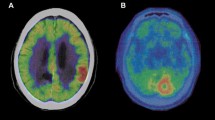Abstract
A stereotactic body frame for exact tumor localization, reproducible fixation, and high-dose fraction irradiation with an accelerator (radiosurgery) has been developed. With the aid of this body frame, tumors are usually treated with five to nine static coplanar or noncoplanar beams yielding a planned inhomogeneous dose distribution with a 50% higher dose in the center of the tumor compared to the periphery of the planning target volume. Due to the steep dose gradient, the surrounding normal tissue is exposed to relatively low doses. Seventy-five evaluable tumors in 50 patients in whom conventional treatment modalities had been exhausted or considered inapplicable have been treated with doses of between 15 and 45 Gy (mean, 28 Gy) at the periphery of the planning target volume delivered in one to five fractions (mean, 2.5). The tumors, which had volumes ranging from 2–732 cm3 (mean, 73 cm3), were mainly metastases, from a variety of primaries, in the liver, lungs, and retroperitoneal space. Some primaries such as lung cancer and primary liver cancer were also treated. During an evaluation period of 1.5–38 months (mean, 11 months) 22 tumors showed growth arrest (29.3%), 29 were reduced in size (38.7%), and 24 disappeared (32%) as judged by computed tomography examinations, which were usually performed at 2- to 3-month intervals after radiosurgery. Four of the tumors were classified as local failures (5.3%). This treatment, which is noninvasive, painless, and rapid and does not require hospitalization, does not impair the quality of life of the patients when used properly. Treatment has been given regardless of age and medical status of the patients.
Similar content being viewed by others
REFERENCES
Kihlström L, Karlsson B, Lindqvist C: Gamma knife surgery for cerebral metastases. Implications for survival based on 16 years experience. Stereotact Funct Neurosurg 61(Suppl 1):45–50, 1993
Coffey RJ, Flickinger JC, Bisonette DJ, Lunsford LD: Radiosurgery for solitary brain metastases using the cobalt-60 gamma unit: Methods and results in 24 patients. Int J Radiat Oncol Biol Phys 20:1287–1295, 1991
Coffey RJ, Flickinger JC, Lunsford LD Bisonette DJ: Solitary brain metastases: Radiosurgery in lieu of microsurgery in 32 patients. Acta Neurochir Suppl 52:90–92, 1991
Flickinger JC, Kondziolka D, Lunsford LD, et al.: A multiinstitutional experience with stereotactic radiosurgery for solitary brain metastases. Int J Radiat Oncol Biol Phys 28:797–802, 1994
Kurtz JM, Gelber R, Brady LW, Carella ZJ, Cooper JS: The palliation of brain metastases in a favorable patient population. A randomized clinical trial by the Radiation Therapy Oncology Group. Int J Radiat Oncol Biol Phys 7:891–895, 1981
Epstein BE, Scott CB, Sause WT, Rotman M, et al.: Improved survival duration in patients with unresected solitary brain metastases using accelerated hyperfractionated radiation therapy at total doses of 54.4 Gy and greater. Cancer 71:1362–1367, 1993
Hoskin PJ, Crow, J, Ford HT: The influence of extent and local management on the outcome of radiotherapy for brain metastases. Int J Radiat Oncol Biol Phys 19:111–115, 1990
Colombo F, Benedetti A, Pozza F, et al.: External stereotactic irradiation by linear accelerator. Neurosurgery 16:154–160, 1985
Greitz T, Lax I, Bergström M, et al.: Stereotactic irradiation therapy of intracranial lesions. Methodological aspects. Acta Radiol Oncol 25:81–89, 1986
Lutz W, Winston K, Maleki N: A system for stereotactic radiosurgery with linear accelerator. Int J Radiat Oncol Biol Phys 14: 371–381, 1988
Lax I, Blomgren H, Näslund I, Svanström R: Stereotactic radiotherapy of malignancies in the abdomen. Methodological aspects. Acta Oncol 33:677–683, 1994
Blomgren H, Lax I, Näslund I, Svanström R: Stereotactic high dose fraction radiation therapy of extracranial tumors using an accelerator. Acta Oncol 34:861–870, 1995
Lax I, Blomgren H, Larsson D, Näslund I: Extracranial stereotactic radiosurgery of localized targets (submitted for publication)
Lax I: Target dose versus extratarget dose in stereotactic radiosurgery. Acta Oncol 32:453–457, 1993
International Commission on Radiation Units and Measurements: Prescribing, Recording and Reporting Photon Beam Therapy, Report 50. Bethesda, MD, ICRU, 1993
Krol ADG, Aussems P, Noordijk EM, Hermans J, Leer JWH: Local irradiation alone for peripheral stage I lung cancer: Could we omit the elective regional nodal irradiation? Int J Radiat Oncol Biol Phys 34:297–302, 1996
Slotman BJ, Antonisse IE, Njo KH: Limited field irradiation in early stage (T1–2 N0) non-small cell lung cancer. Radiother Oncol 41:41–44, 1996
Author information
Authors and Affiliations
Rights and permissions
About this article
Cite this article
Blomgren, H., Lax, I., Göranson, H. et al. Radiosurgery for Tumors in the Body: Clinical Experience Using a New Method. Journal of Radiosurgery 1, 63–74 (1998). https://doi.org/10.1023/B:JORA.0000010880.40483.c4
Issue Date:
DOI: https://doi.org/10.1023/B:JORA.0000010880.40483.c4




